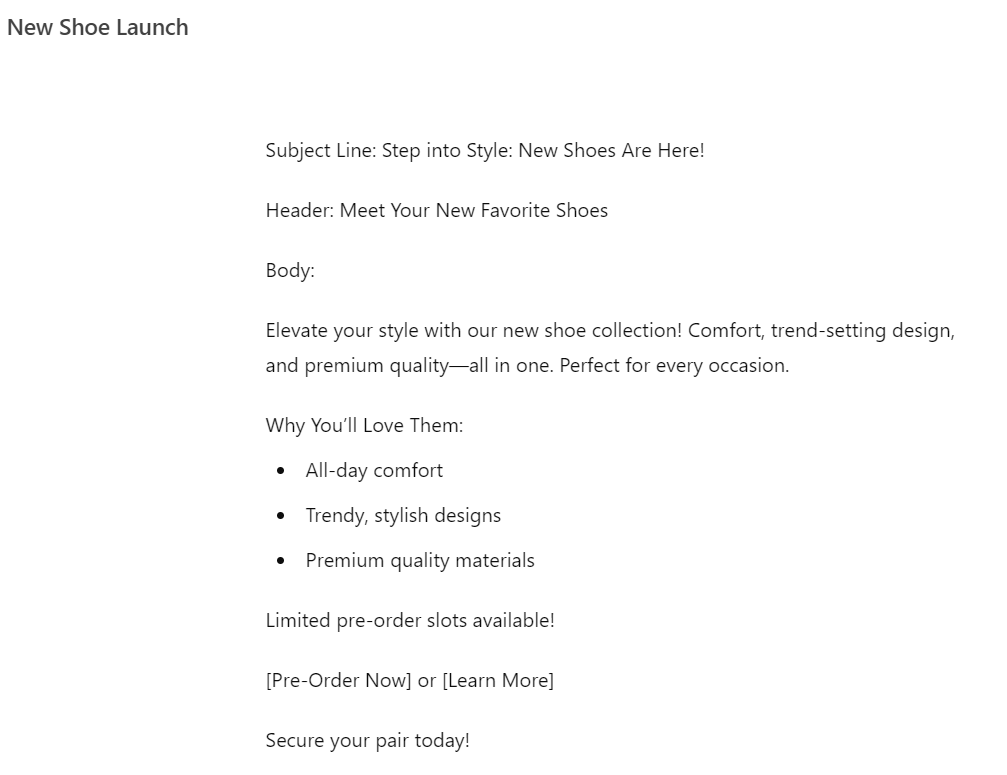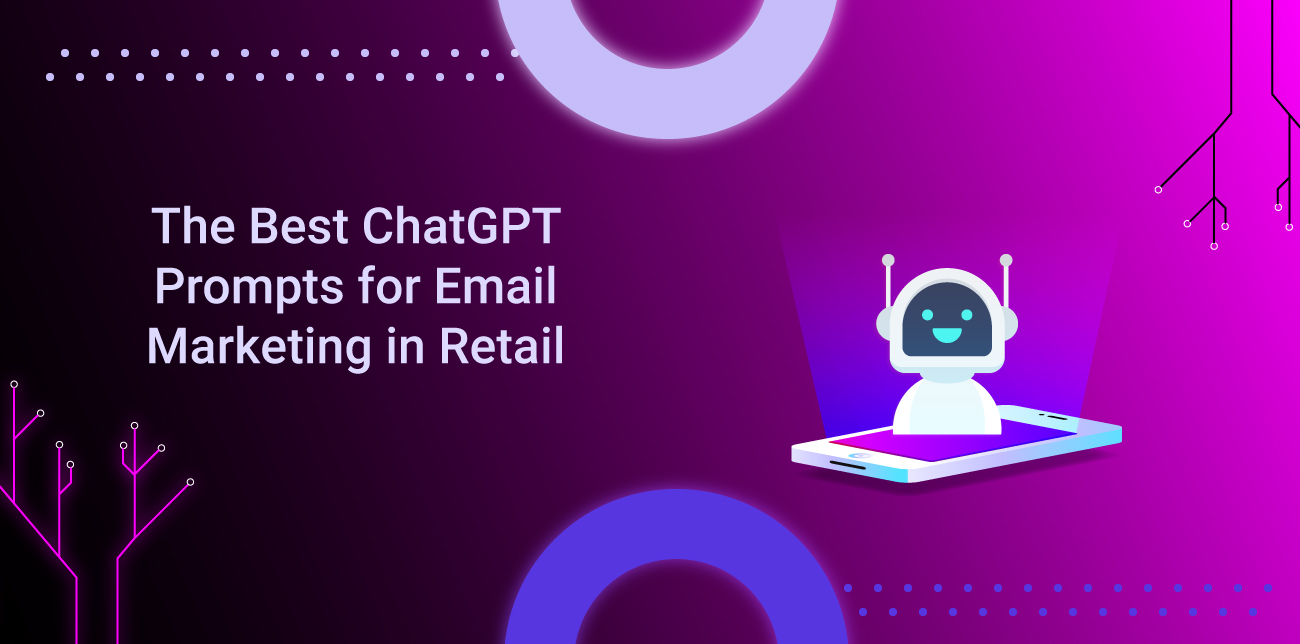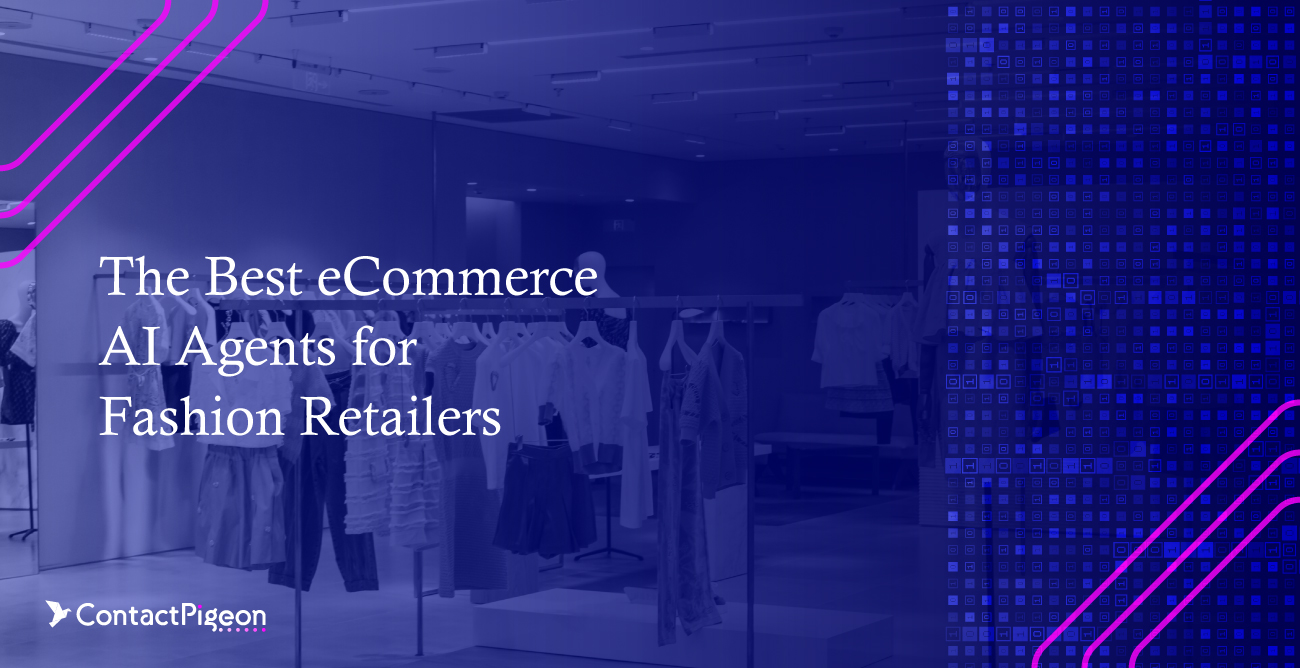AI is revolutionizing email marketing in the retail industry, providing powerful tools to enhance customer engagement and streamline campaign management. By using AI-driven strategies, retailers can boost open rates by up to 41%, reduce overhead costs by 7.2%, and deliver personalized experiences—88% of marketers agree AI has enhanced their ability to customize the customer journey (businessdasher.com). In this article, we’ve gathered the best ChatGPT prompts to help you craft more compelling content, optimize your email marketing in retail, and ultimately increase sales by connecting with your audience in a more meaningful way.
The 40 best ChatGPT prompts for email marketing retail professionals
Discover how these carefully crafted prompts can transform your AI email marketing strategies and help you connect better with your retail customers.
ChatGPT prompts for email marketing in retail: Automated campaigns

Automated email campaigns can help retailers stay connected with their customers while saving time and driving engagement effortlessly.
Welcome email sequence
- Basic prompt: “Create a welcome email for new subscribers to introduce our brand, highlight key products, and offer a first-time purchase discount.”
- Follow-up prompt: “Please write a follow-up email to nurture new subscribers, featuring customer testimonials and popular product categories.”
Abandoned cart email
- Basic prompt: “Generate a friendly, persuasive email encouraging customers to complete their purchase of items left in their cart. Mention the specific products and include a subtle discount offer to entice them.”
- Follow-up prompt: “Create a follow-up email for customers who haven’t responded to the first abandoned cart email. Emphasize scarcity or limited stock to encourage urgency.”
Cross-sell campaigns
- Basic prompt: “Generate an email campaign to cross-sell related products to customers who recently purchased [specific product]. Make sure to highlight complementary items and offer a small incentive.”
- Follow-up prompt: “Please personalize the email based on the customer’s purchase history and suggest product pairings with a clear call-to-action.”
Customer review request
- Basic prompt: “Write a follow-up email asking customers who purchased [specific product] to leave a review. Include a thank you note and a simple, clear review link.”
- Follow-up prompt: “Can you also suggest a version that offers a small discount as a thank you for leaving a review?”
Re-order reminder emails
- Basic prompt: “Write an email to remind customers about re-ordering [product] they’ve previously purchased, focusing on convenience and their past satisfaction.”
- Follow-up prompt: “Please add a personalized message that highlights how long it’s been since their last order and offer an exclusive discount for their next purchase.”
Cross-sell campaigns
- Basic prompt: “Generate an email campaign to cross-sell related products to customers who recently purchased [specific product]. Make sure to highlight complementary items and offer a small incentive.”
- Follow-up prompt: “Please personalize the email based on the customer’s purchase history and suggest product pairings with a clear call-to-action.”
Re-engagement campaigns
- Basic prompt: “Generate a re-engagement email to win back customers who haven’t interacted in a while. Mention what’s new in our store and offer a special incentive, like a discount or exclusive content.”
- Follow-up prompt: “Draft a follow-up re-engagement email for those who didn’t respond, emphasizing that this is their last chance to claim the incentive and reminding them of the value they’ve experienced with our brand.”
Post-purchase follow-up emails
- Basic prompt: “Write a follow-up email to thank a customer for their recent purchase of [specific product], and suggest related products they might like.”
- Follow-up prompt: “Please add a personalized recommendation based on the customer’s past purchase patterns and offer a loyalty discount on the next purchase.”
Milestone campaigns
- Basic prompt: “Write an email celebrating a customer’s anniversary with our brand, including a special reward or discount for their loyalty.”
- Follow-up prompt: “Please make the message more personal by highlighting their most purchased product category and offering a personalized discount.”
ChatGPT prompts for email marketing in retail: Boost efficiency

Use these prompts to streamline your email marketing process, save time, and achieve consistent, high-quality results
Creating engaging subject lines
- Basic prompt: “Generate a catchy and engaging subject line for an email promoting [specific product] to retail customers.”
- Follow-up prompt: “Now, please suggest five variations of this subject line based on customer segmentation best practices.”
Eye-catching email preview text
- Basic prompt: “Generate a catchy and engaging Email Preview Text for an email campaign with the title [email campaign title]”
- Follow-up prompt: “Now, suggest five more variations, based on customer segmentation best practices, please.”
Creating stunning email header images
- Basic prompt: “Can you create an engaging email body promoting [specific product or offer], focusing on clear benefits for the customer and a strong call to action?”
- Follow-up prompt: “Please make it more specific to [product category] and [brand name here]’s USPs.”
Email body copywriting
- Basic prompt: “Can you create an engaging email body promoting [specific product or offer], focusing on clear benefits for the customer and a strong call to action?”
- Follow-up prompt: “Please make it more specific to [product category] and [brand name here]’s USPs.”
High-performing email CTAs
- Basic prompt: “Can you suggest a compelling call-to-action (CTA) for an email campaign aimed at driving purchases of [specific product or service]?”
- Follow-up prompt: “Please create five variations of the CTA that focus on urgency, exclusivity, and personalization to improve click-through rates.
ChatGPT prompts for email marketing in retail: Boost optimization

Maximize your email campaigns’ effectiveness with these prompts designed to improve targeting, timing, and overall performance.
Personalized email content
- Basic prompt: “How can I personalize an email for a customer who frequently purchases [product type] from our retail store?”
- Follow-up prompt: “Please include dynamic content examples based on customer purchase history and browsing behavior for industry [industry name here].”
Improved email open rates
- Basic prompt: “What can I do to increase the open rates of my retail email campaigns?”
- Follow-up prompt: “Please provide actionable tips based on global best practices for email marketing in retail.”
A/B Testing in email campaigns
- Basic prompt: “Can you create two versions of an email for an A/B test to see which one leads to more conversions?”
- Follow-up prompt: “Please include suggestions for testing subject lines, email copy, and CTAs.”
Reducing email unsubscribe rates
- Basic prompt: “Suggest ways to reduce unsubscribe rates for my retail email campaigns. What can I change about my email strategy to keep customers engaged?”
- Follow-up prompt: “Based on these suggestions, draft a sample ‘preferences management’ email that allows users to customize the types of emails they receive.”
Loyalty program enrollment
- Basic prompt: “Write an email inviting customers to join our loyalty program, highlighting the exclusive rewards, discounts, and benefits they’ll receive upon joining.”
- Follow-up prompt: “Draft a follow-up email for those who haven’t signed up yet, focusing on how easy it is to enroll and sharing testimonials from existing loyalty program members.”
Product launch announcements
- Basic prompt: “Create an exciting product launch email announcing our new [product name]. Highlight its key features and why customers will love it, and include a call-to-action to learn more or pre-order.”
- Follow-up prompt: “Write a follow-up email to remind customers about the new product, focusing on customer reviews, use cases, or limited-time offers to drive conversions.”
Mistakes to avoid
By avoiding these common pitfalls, you can make the most of AI in your email marketing strategy while keeping your audience engaged and building trust.
- Over-automation without personal touch: While AI can automate email creation and scheduling, relying solely on automation can make your emails feel impersonal. It’s crucial to maintain a human element to keep communication engaging and relatable.
- Ignoring data quality: AI relies heavily on data to personalize and optimize emails. Using poor-quality or outdated data can lead to irrelevant content, harming your credibility and reducing open rates. Always keep your data clean and updated.
- Lack of testing: AI tools can generate subject lines and email content, but failing to test different versions can mean missed opportunities. A/B testing helps determine what resonates best with your audience.
- Generic messaging: AI allows for personalization, but if you don’t customize prompts correctly, it may generate generic or irrelevant messages. Ensure your prompts are specific to your audience’s preferences to keep them engaged.
- Overuse of AI jargon: Including too much technical or AI-related jargon in your emails can alienate customers. Make sure the content generated by AI is simple, friendly, and easy to understand.
- Ignoring AI-generated insights: AI can provide valuable insights into customer behavior and preferences. Not using these insights to further optimize your campaigns is a missed opportunity for improving open rates and engagement.
- Failing to monitor campaigns: Relying solely on AI without actively monitoring campaign performance can be risky. Keep an eye on metrics such as open rates, click-through rates, and conversions to make adjustments where needed.
- Over-personalizing: Over-personalizing to the point of being invasive or cringeworthy can make customers uncomfortable and damage your relationship with them. Personalization should be relevant, but not cross personal boundaries.
- Using AI without human review: Relying entirely on AI to generate content without human oversight can lead to mistakes, awkward phrasing, or inappropriate messaging. Always review AI-generated content to ensure it aligns with your brand’s tone and standards.
- Focusing only on sales: Focusing solely on sales without providing customer value through your email campaigns can lead to disengagement. Make sure your emails (automated or not) provide helpful content, exclusive information, or other value beyond just selling.
AI-powered email marketing for leading retailers
In conclusion, ChatGPT has revolutionized the way retailers approach email marketing, offering unparalleled opportunities for personalization, automation, and optimization. By combining the innovative potential of AI with the practical guidance provided in this article, you can take your email campaigns to the next level and drive real results for your business.
However, to truly unlock the full potential of ChatGPT and AI-powered marketing, you need a robust customer data platform (CDP) to centralize and unify your customer data. For instance, a CDP allows you to integrate data from various touchpoints, like purchase history and website interactions, to create highly personalized email campaigns that resonate with individual customers, thereby skyrocketing your marketing effectiveness. We can help you with customer data and behavior to power your emails. With ContactPigeon’s Customer Data Platform, you can effortlessly manage your customer data, automate your emails, and personalize your messages to drive sales and customer loyalty.
Want to take your email marketing to the next level? Contact ContactPigeon to learn more about our CDP and how it can help you maximize the impact of your ChatGPT-powered emails.

Let’s Help You Scale Up



